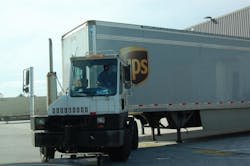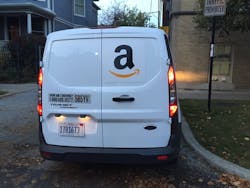Frankly, it’s not too surprising that e-commerce mega-retailer Amazon is perceived as the proverbial 900-lb. gorilla of the freight world right now.
[And let me tell you, a 900-lb. gorilla is a BIG gorilla; but not as big as this one …]
Amazon is becoming such a heavy-hitter in transportation and logistics circles due to some very simple reasons; ones largely related to changing desires and habits on the part of consumers.
For starters, consumers are literally flocking in hordes to buy the goods sold via its online. Indeed, Amazon accounted for almost half of all online holiday sales in 2016 and is, in the words of PowerReviews, “the undisputed e-commerce market leader.”
And the e-commerce market continues to grow quite fast. Kenny Vieth, president and senior analyst with ACT Research, noted in an interview with me last year that as a percentage of sales, excluding food, e-commerce made up 24.3% of retail sales in the second quarter of 2016, compared to just 3% – yes, just a measly 3% – back in 2001.
Here’s how that impacts freight transportation firms: all of those online purchases are being shipped directly to consumers at almost unheard of velocity. And the low-cost yet high-speed nature of those deliveries is markedly changing consumer expectations of freight transportation: mainly, they now expect freight transportation to be both fast and free, with those terms not mutually exclusive.
Jumping back to PowerReviews for a moment: that company conducted a survey among 1,000 U.S. shoppers aged 18 and over and discovered some interesting trends. Right off the bat, the firm’s survey found that 71% of shoppers make at least one Amazon purchase a month and cite the following reasons for doing so:
- Variety of Products: 79%
- Free Shipping: 64%
- Better Deals: 60%
- Volume of Customer Reviews: 55%
- Search Capabilities: 54%
- Mobile Experience: 29%
“Our survey found that consumers biggest pain point pre- and post- purchase was not having enough information,” noted Matt Moog, CEO of PowerReviews, in the firm’s report.
“[But] Amazon provides rich content in the form of product reviews, photos, videos and descriptions to build trust. Consumers have come to not only rely on this information but expect brands and retailers to provide it as well,” he stressed. “Retailers are under no illusion about the competition they face.”Transportation and logistics companies themselves are bearing witness to the changes being wrought by e-commerce activity – and thus, by extension, Amazon – on the freight world.
Take the annual Pulse of the Online Shopper survey conducted by United Parcel Service (UPS). Last year, the company’s poll of 5,000 U.S. online shoppers found that free shipping continues to be the most important factor driving customer satisfaction when checking out online (73%), although consumers are willing to pay a premium for faster delivery. Half of shoppers (50%) would pay for faster shipping for personal reasons, such as birthdays and holidays.
And while home delivery is still the preferred location to receive packages, more consumers are embracing alternate delivery locations. Preference for alternate delivery locations grew nine points (to 35%) in the last two years, UPS said, with more than half of shoppers are interested in an alternate delivery location with extended hours and lower fees.
“These are exciting and challenging times for retailers,” noted Teresa Finley, chief marketing officer at UPS, in the study. “The industry is changing at an incredibly fast rate. Listening closely to what shoppers want and boldly trying new techniques can give retailers a competitive advantage in this very competitive industry.”
That “competition” is also increasing on the transportation side of the e-commerce equation as well, due, again, to how Amazon is not only changing customer expectations but is stepping up its own efforts to handle such shipments directly on its own.
John Larkin, managing director and head of transportation capital markets research for Stifel Capital Markets, pointed this out earlier this year as part of his “top trends list” for 2017.
“Amazon’s entire infrastructure network is geared for speed and in the case where strategic logistics partners are not up to the challenge, it’s beginning to provide transportation and logistics services itself,” Larkin noted.“Just in the past year or two, the company has rolled out its own trailer fleet, has developed an uber-like last mile delivery process named Flex, has received its license to operate as a non-vessel owning common carrier (NVOCC) in the international container shipper market, has developed its own air parcel hubs with its ‘own’ dedicated aircraft, has been at work developing its own truck brokerage operation, and recently revealed a plan to deliver packages by drone from airborne warehouses,” he said.
“All of this activity doesn’t even speak to the 20 or so new distribution centers and fulfillment centers the company has constructed in 2016 in the U.S., not to mention around the world,” Larkin added.
“While the company builds out its network and its network freight density and potentially an insurmountable lead in the e-commerce space, carriers and 3PLs [third party logistics providers] alike must develop an Amazon strategy,” he stressed. “Either engage in a fully-integrated, collaborative partnership with Amazon, or align with more traditional, slower moving customers. It may well prove difficult to serve both of these ‘masters’ sustainably.”
Steve Sashihara – the founder and CEO of Princeton Consultants – expanded on Larkin’s observations with his own analysis of how so-called “disruptive technologies” are changing the face of transportation and logistics, again highlighting Amazon.
“Those who believe ‘Uberization’ will turn the third party transportation brokerage industry on its proverbial head argue that freight transportation service is hard to differentiate and, at its core, is essentially a commodity,” he explained in a recent conference call hosted by Stifel.
“The other side of the argument suggests that no two loads of freight are the same and there are simply too many permutations – i.e., shipper preferences, receiver preferences, trailer size, trailer type, driver type, special handling requirements, etc. – for a ‘traffic manager’ to turn over a $500,000 load of freight to an ‘app,’” Sashihara noted.Yet he thinks that short-haul, same day freight moves in and around metropolises are handled by motor carriers whose trucks are “chock full” of under-utilized cubic capacity or that are fraught with excessive downtime between loads – inefficiencies that could, in theory at least, be squeezed out of the industry in these urban environments.
“Secondly, an ‘Uberized’ approach would provide enhanced, real-time situational awareness to shippers, receivers, 3PLs [third party logistics companies], brokers, [motor] carriers, drivers, etc.,” Sashihara noted. “Again efficiencies could be generated by reducing empty miles and potentially wasted available hours-of-service.”
Here’s the kicker: while he believes large 3PLs and freight brokers should still retain a “leg up” on the start-ups and smaller “tech savvy” brokers, but they will need to incrementally “Uberize” at a steady pace over the coming five to 10 years in order to avoid being leapfrogged by new competitors – the biggest one being Amazon.
“Amazon can buy or invent the technology, hire the relevant talent, and use its own base load volume to prime the pump on its own ‘Uberized’ 3PL,” he stressed.
Not many companies can do all of that, which is why Amazon may retain its 900-lb. gorilla status for some time to come.
About the Author
Sean Kilcarr
Editor in Chief
Sean Kilcarr is a former longtime FleetOwner senior editor who wrote for the publication from 2000 to 2018. He served as editor-in-chief from 2017 to 2018.



